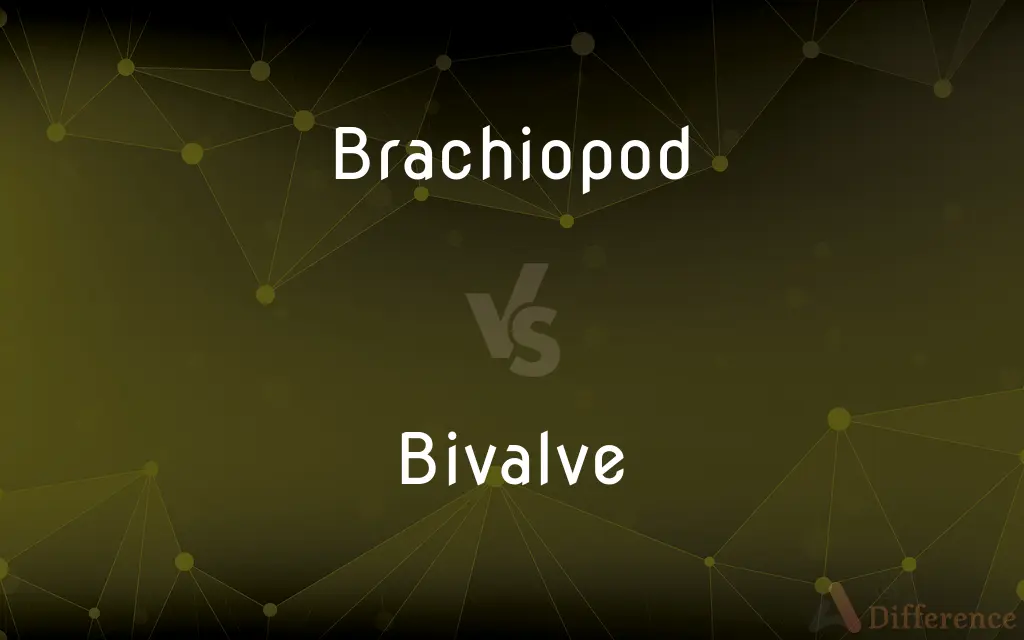Brachiopod vs. Bivalve — What's the Difference?
By Tayyaba Rehman — Updated on September 30, 2023
Brachiopod is marine animal with upper and lower shells and a stalk. Bivalve is an aquatic mollusk with two hinged shells, like a clam.

Difference Between Brachiopod and Bivalve
Table of Contents
ADVERTISEMENT
Key Differences
Brachiopods and Bivalves are both marine organisms known for their shell-covered bodies, but they are significantly different in terms of anatomy, ecology, and evolutionary history. Brachiopods are marine animals characterized by having upper and lower shells usually of different sizes and are attached to the substrate by a stalk or pedicle. Bivalves, conversely, belong to the class Bivalvia and include clams, oysters, and mussels, characterized by having two usually symmetrical shells hinged at one end.
While Brachiopods have been prevalent in the oceans since the Cambrian period, their diversity and abundance have decreased over time, leaving a relatively small number of extant species. Bivalves, in contrast, are highly diverse and abundant, found in a variety of marine and freshwater habitats, and are significant both ecologically and economically, with many species being important sources of food for humans.
In terms of anatomy, Brachiopods have a lophophore, a specialized feeding structure, and their shells are made of calcium phosphate. Bivalves lack a lophophore and instead have gills for filter-feeding, and their shells are primarily composed of calcium carbonate. Bivalves also typically have a more developed muscular system compared to Brachiopods, allowing them to actively open and close their shells.
Brachiopods and Bivalves also differ in terms of their ecological roles and life strategies. Brachiopods are primarily sessile, attaching themselves to substrates in deep and cold marine environments, often with low light and current. Bivalves exhibit a wider range of life strategies and can be found buried in sediment, attached to surfaces, or free-living in both marine and freshwater environments, and they often play crucial roles in aquatic ecosystems as filter feeders.
Comparison Chart
Taxonomic Position
Phylum Brachiopoda.
Class Bivalvia, Phylum Mollusca.
ADVERTISEMENT
Shell Composition
Composed mainly of calcium phosphate.
Primarily composed of calcium carbonate.
Anatomy
Possess a lophophore for feeding.
Have gills and a more developed muscular system for filter-feeding.
Ecological Role
Sessile, mainly in deep, cold marine environments.
Diverse; found in marine and freshwater, significant filter feeders.
Diversity & Abundance
Fewer extant species, decreased over time.
Highly diverse and abundant, ecologically and economically significant.
Compare with Definitions
Brachiopod
Marine creature with shells composed mainly of calcium phosphate.
The mineral composition of the brachiopod shell is distinct from many marine organisms.
Bivalve
An aquatic mollusk having a shell divided into two hinged parts.
The clam, a type of bivalve, is commonly found along coastlines.
Brachiopod
A marine invertebrate with distinct upper and lower shells.
The fossil record is abundant with various species of brachiopod.
Bivalve
Possesses a muscular system allowing active shell movement.
The bivalve can tightly shut its shell as a defense mechanism.
Brachiopod
An animal phylum characterized by a stalk attaching them to the substrate.
The brachiopod anchors itself to the sea floor with a pedicle.
Bivalve
Known for its filter-feeding capability through gills.
The filter-feeding bivalve plays a crucial role in maintaining water quality.
Brachiopod
Known for its rich fossil record, dating back to the Cambrian period.
Studying the brachiopod provides insight into Earth’s ancient marine ecosystems.
Bivalve
Exhibits diverse ecological adaptations, found in various aquatic habitats.
Different species of bivalve have adapted to a wide range of aquatic environments.
Brachiopod
Organism predominantly found in cold and deep marine environments.
This species of brachiopod thrives in low-light marine settings.
Bivalve
Marine or freshwater organism, with species significant as human food sources.
Oysters, another variety of bivalve, are cultivated for culinary use.
Brachiopod
Brachiopods (), phylum Brachiopoda, are a phylum of trochozoan animals that have hard "valves" (shells) on the upper and lower surfaces, unlike the left and right arrangement in bivalve molluscs. Brachiopod valves are hinged at the rear end, while the front can be opened for feeding or closed for protection.
Bivalve
Any of numerous freshwater and marine mollusks of the class Bivalvia, having a shell consisting of two hinged valves connected by a ligament, and including the clams, mussels, oysters, and scallops. Also called lamellibranch, pelecypod.
Brachiopod
Any of numerous marine invertebrates of the phylum Brachiopoda, having a shell with two valves of unequal size enclosing an armlike lophophore used for feeding, and including many extinct species commonly found as fossils. Also called lampshell.
Bivalve
Having a shell consisting of two hinged valves.
Brachiopod
Any of many marine invertebrates, of the phylum Brachiopoda, that have bivalve dorsal and ventral shells with two tentacle-bearing arms that capture food
Bivalve
Consisting of two similar separable parts.
Brachiopod
One of the Brachiopoda, or its shell.
Bivalve
Any mollusc belonging to the taxonomic class Bivalvia, characterized by a shell consisting of two hinged sections, such as a scallop, clam, mussel or oyster.
Brachiopod
Marine animal with bivalve shell having a pair of arms bearing tentacles for capturing food; found worldwide
Bivalve
(botany) A pericarp in which the seed case opens or splits into two parts or valves.
Brachiopod
Of or belonging to the phylum Brachiopoda
Bivalve
A mollusk having a shell consisting of two lateral plates or valves joined together by an elastic ligament at the hinge, which is usually strengthened by prominences called teeth. The shell is closed by the contraction of two transverse muscles attached to the inner surface, as in the clam, - or by one, as in the oyster. See Mollusca.
Bivalve
A pericarp in which the seed case opens or splits into two parts or valves.
Bivalve
Having two shells or valves which open and shut, as the oyster and certain seed vessels.
Bivalve
Marine or freshwater mollusks having a soft body with platelike gills enclosed within two shells hinged together
Bivalve
Used of mollusks having two shells (as clams etc.)
Common Curiosities
Do Bivalves have a developed muscular system?
Yes, Bivalves have a more developed muscular system allowing them to actively open and close their shells.
Are Brachiopods common today?
No, Brachiopods are less common today with fewer extant species.
What is the Brachiopod’s shell composed of?
The Brachiopod’s shell is primarily composed of calcium phosphate.
What is a Brachiopod?
A Brachiopod is a marine animal with distinct upper and lower shells, usually attached to the substrate by a stalk.
Are Bivalves edible?
Yes, many Bivalves like clams, oysters, and mussels are edible and are important food sources.
Do Bivalves have varied ecological roles?
Yes, Bivalves exhibit diverse ecological adaptations and play varied roles in different aquatic habitats.
How do Bivalves contribute to the ecosystem?
Bivalves play significant roles in aquatic ecosystems as filter feeders, improving water quality.
Are Bivalves symmetrical?
Yes, Bivalves usually have two symmetrical shells hinged at one end.
Is the Brachiopod rich in fossil records?
Yes, Brachiopods have a rich fossil record, providing insight into ancient marine life.
How does a Brachiopod feed?
Brachiopods feed using a specialized structure called a lophophore.
Can Brachiopods move?
Brachiopods are primarily sessile, typically attaching themselves to substrates.
Can Bivalves live in freshwater?
Yes, Bivalves can be found in both marine and freshwater environments.
Where are Brachiopods mainly found?
Brachiopods are mainly found in deep, cold marine environments with low light.
What is the main component of a Bivalve’s shell?
The main component of a Bivalve’s shell is calcium carbonate.
Share Your Discovery

Previous Comparison
Backlit vs. Backlight
Next Comparison
Compulsion vs. ImpulsionAuthor Spotlight
Written by
Tayyaba RehmanTayyaba Rehman is a distinguished writer, currently serving as a primary contributor to askdifference.com. As a researcher in semantics and etymology, Tayyaba's passion for the complexity of languages and their distinctions has found a perfect home on the platform. Tayyaba delves into the intricacies of language, distinguishing between commonly confused words and phrases, thereby providing clarity for readers worldwide.














































